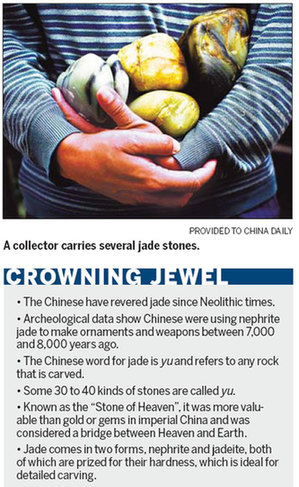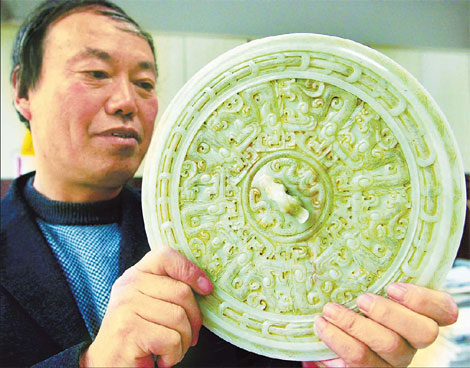Chinese Way
Crazy stone
Updated: 2011-03-29 07:54
By Liu Lu (China Daily)
|
A collector in Zhejiang province displays a jade mirror from the Han Dynasty (206 BC-AD 220). Pan Lianggan / For China Daily |
Jade is an iconic symbol of Chinese culture and its continued popularity ensures that its worth increases. Liu Lu reports.
Gold has a price, but jade is priceless, goes an old Chinese saying. Even so, last year jade rose nearly 30 percent in price, according to the Gems & Jewelry Trade Association of China (GJTAC). While the value of other gemstones fluctuate, the price of jade in China continues to rise every year, making it one of the least affected commodities during economic downturns.
At auction houses, jade always attracts major investors. In 2010 an imperial white jade seal fetched $12.4 million at a Hong Kong auction, smashing the auction world record for a white jade or imperial seal.
The imperial jewel was inscribed Tai Shang Huang Di or "Supreme Majesty", referring to its user, the Qianlong emperor (1711-1799) of the Qing Dynasty (1644-1911).
But jade is not simply a piece of fine decorative stone for Chinese people. It is also a gem of high aesthetic value and has been used in the Middle Kingdom for more than 7,000 years. It continues to be a symbol synonymous with Chinese culture.
 |
It is one of the most popular items tourists buy when visiting China and even played a gold medal role at the Beijing Olympic Games. The medals awarded to the world's best athletes in 2008 incorporated polished jade, which featured the pattern of a dragon.
"The Chinese believe that jade is a treasure bestowed to the human world by heaven," says Yan Zengfeng, a jewelry expert with GJTAC. "They think each piece of jade absorbs nature's essence, that has developed over millions of years."
Because of its toughness and unique texture, he says, jade has become a symbol of China's magnificent civilization, and it has long been regarded as a stone that symbolizes beauty, nobility and virtue, which is an embodiment of the traditional Chinese values of ethics and honor.
"It is often said that if a person wears jade, such as a bracelet, for a long time it will suck away the bad spirits from the wearer, making the person healthier, and the jade itself will become more lustrous, glossy and transparent," Yan says.
Belief in the healing powers of the gemstone is not only a Chinese concept but was also shared by Europeans in the 16th century.
The English word jade is derived (via French l'ejade and Latin ilia) from the Spanish term piedra de ijada, which was first recorded in the mid-1500s. It means "loin stone" because of its reputed ability to cure ailments of the loins and kidneys.
No matter what powers jade may have, the mystery, legend and romance surrounding it and its status as China's most prized precious stone continues to create demand.
"Collecting jade stones is an investment that can be expensive at first but over time can earn you big bucks, because the value of jade increases fast," says Fu Yongkuan, 54, an antique and art collector in Beijing. He has collected jade items for 15 years and says now is the time to buy.
"The price of a piece of jade I bought from a friend several years ago has at least tripled now," Fu says, adding that the skyrocketing price of jade has driven more speculators to cash in on the craze.
In addition to individual investors, some institutional investors have also eyed the market, convinced of its appreciation.
"Although jade collection is profitable, it is vital for buyers to have some appreciation to avoid buying fake pieces," says Song Yong, sales manager of the jade stone department of artxun.com, China's largest online art collection marketplace.
Song says his company's jade online store opened in April, 2010 and after a slow start, has seen major sales growth.
"In the first month we were selling less than five inexpensive jade pieces, but after running for a while, the monthly sales volume has reached more than 100 pieces," Song says.
He says the scarcity of jade and the rising costs of labor, transportation and processing have all contributed to the higher prices, making him optimistic about the prospects of the domestic jade market.
But some experts worry that the boom in jade investment may lead to the over-exploitation of jade ore and the destruction of the environment.
"Jade is a scarce and non-renewable resource, which is a great wealth left by nature," says Bai Miao, the deputy secretary general of the jade culture committee of the China National Light Industry Council.
"But instead of preserving and making good use of this rare resource, some local governments are blindly pursuing short-term economic interests and randomly digging up the jade ore and selling it at low prices.
"This is not only a huge waste, but also severely damages the ecological balance."
To halt the environmental destruction, the Chinese government recently instituted reforms to regulate jade mining. It now prohibits commercial digging along forests and riverbanks.
In 2006, the central government banned jade mining in Xinjiang Uygur autonomous region, a major jade producing area famous for Hotan jade, which is a rare variety noted for its whiteness and flawlessness.
Bai says before the ban, the mining leases cost only 6,000 yuan ($915) for 0.067 acre of land and miners could dig as deep as they wanted. The result was serious loss of water and soil erosion, as well as the speeding up of desertification.
"It's good news that the government is taking measures to protect jade but I expect more to come," Bai says.
"As an important and irreplaceable part of Chinese culture, the preservation of jade is in fact the preservation of Chinese civilization. We must leave some wealth to future generations."
Specials

Fill dad's shoes
Daughter and son are beginning to take over the family business of making shoes.

Have you any wool?
The new stars of Chinese animation are edging out old childhood icons like Mickey Mouse and Hello Kitty.

Virtual memorial
High-Tech touches to traditional tombsweeping festival help environment
